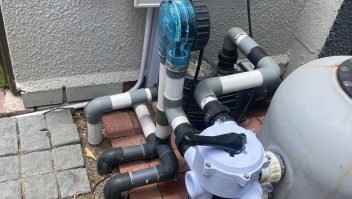When it comes to swimming pool safety, few features are as important as non-slip steps and surfaces. Slippery pool steps are a serious hazard, especially for children, elderly swimmers, and anyone entering or exiting the pool. Installing or upgrading to non-slip swimming pool steps not only prevents accidents but also improves comfort and aesthetic appeal.
In this guide, we’ll explore how to create safe, non-slip steps in all types of pools — fibreglass, gunite (marbelite), vinyl liner, saltwater, chlorine water, and natural swimming pools — while keeping Cape Town and Western Cape pool owners in mind.
Why Non-Slip Pool Steps Are Essential
Every pool owner should make safety a top priority. Non-slip steps:
- Prevent slips and falls during entry and exit.
- Offer better grip for swimmers with wet feet.
- Improve visual safety by clearly marking step edges.
- Add value to your pool during resale.
Whether you have a small plunge pool or a large commercial pool, the investment in non-slip surfaces pays for itself in safety and peace of mind.
How to Create Non-Slip Steps in Different Pool Types
1. Fibreglass Pools
Fibreglass pools often have moulded steps built into the shell.
Non-slip solutions:
- Use factory-applied textured gelcoat for traction.
- Apply two-part epoxy non-slip coating with embedded silica or rubber grit.
- Add PVC step mats designed for underwater use for extra grip.
Tip: Avoid coarse grit in fibreglass — it can damage skin. Instead, choose fine textured finishes.
2. Gunite / Marbelite Pools
Gunite or marbelite steps are often tiled or plastered, which can be slippery.
Non-slip methods:
- Install mosaic tiles with a textured finish on each step edge.
- Use epoxy coatings mixed with anti-slip aggregate for long-lasting grip.
- Apply specialised marbelite finishes with roughened texture in step areas.
Extra Safety Idea: Contrast-coloured step edges make them more visible under water.
3. Vinyl Liner Pools
Vinyl liners are smooth, so they need extra care for non-slip safety.
Best options:
- Integrate non-slip vinyl material on the step section during liner manufacturing.
- Add bolt-on fibreglass or thermoplastic steps with textured surfaces.
- Use removable non-slip mats rated for pool use.
4. Saltwater Pools
Saltwater systems can wear surfaces faster, so materials must be durable.
Recommended approach:
- Use marine-grade epoxy with anti-slip texture.
- Avoid metal treads that corrode in saltwater — choose PVC or composite inserts.
- Opt for slip-resistant tiles with a high grip rating.
5. Chlorine Water Pools
For chlorinated pools, chemical-resistant finishes are a must.
Best practices:
- Apply chlorine-resistant epoxy coatings with non-slip texture.
- Choose ceramic tiles with a minimum slip-resistance rating of R11.
- Seal steps regularly to prevent algae build-up, which causes slipperiness.
6. Natural Swimming Pools
These eco-friendly pools require safe, organic-looking step solutions.
Options:
- Build stone steps with naturally textured surfaces.
- Use timber decking steps treated for slip-resistance.
- Place submerged boulders with naturally grippy textures for entry points.
Extra Safety Enhancements for All Pools
- Handrails: Stainless steel or powder-coated rails make entry and exit safer.
- Step Markings: Contrasting colours or tiles for visibility.
- Underwater Lighting: Highlights steps at night.
- Regular Cleaning: Prevents algae and biofilm that create slippery surfaces.
Optimised FAQ Section
Q1: How do I make my pool steps non-slip?
You can use textured epoxy coatings, slip-resistant tiles, or underwater mats. The best choice depends on your pool type and water chemistry.
Q2: Can you add non-slip steps to an existing pool?
Yes, you can retrofit steps with anti-slip coatings, overlays, or add-on step units.
Q3: Are non-slip surfaces safe for barefoot swimmers?
Yes, provided you choose a fine-textured finish that offers grip without abrasiveness.
Q4: Do non-slip coatings work in saltwater pools?
Yes, but you should choose marine-grade epoxy or salt-resistant tiles for durability.
Q5: How often should I maintain non-slip steps?
Inspect them every 6–12 months and reapply coatings or clean surfaces to maintain grip.
Related Internal Links
Helpful External Resources
- NSPI – National Spa & Pool Institute Safety Guidelines
- World Health Organization – Swimming Pool Safety
Tip for Pool Owners: Whether you own a fibreglass, gunite, vinyl, chlorine, saltwater, or natural swimming pool, installing non-slip steps and surfaces is one of the smartest upgrades you can make for safety, comfort, and peace of mind.



